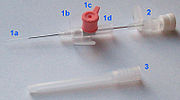
Peripheral venous catheter
Encyclopedia


Medicine
Medicine is the science and art of healing. It encompasses a variety of health care practices evolved to maintain and restore health by the prevention and treatment of illness....
, a peripheral venous catheter (PVC or peripheral venous line or peripheral venous access catheter) is a catheter
Catheter
In medicine, a catheter is a tube that can be inserted into a body cavity, duct, or vessel. Catheters thereby allow drainage, administration of fluids or gases, or access by surgical instruments. The process of inserting a catheter is catheterization...
(small, flexible tube) placed into a peripheral vein
Peripheral vein
Peripheral Veins are the veins not in the chest or abdomen . These veins lead deoxygenated blood from the capillaries in the extremities back to the heart....
in order to administer medication or fluids
Intravenous therapy
Intravenous therapy or IV therapy is the infusion of liquid substances directly into a vein. The word intravenous simply means "within a vein". Therapies administered intravenously are often called specialty pharmaceuticals...
. Upon insertion, the line can be used to draw blood
Venipuncture
In medicine, venepuncture, venopuncture or venipuncture is the process of obtaining intravenous access for the purpose of intravenous therapy or for blood sampling of venous blood. This procedure is performed by medical laboratory scientists, medical practitioners, some EMTs, paramedics,...
.
The catheter is introduced into the vein by a needle (similar to blood drawing), which is subsequently removed while the small tube of the cannula remains in place. The catheter is then fixed by taping it to the patient's skin (unless there is allergy to adhesives). Newer catheters have been equipped with additional safety features to avoid needlestick injuries
Needlestick injury
A needlestick injury is a percutaneous piercing wound typically set by a needle point, but possibly also by other sharp instruments or objects. Commonly encountered by people handling needles in the medical setting, such injuries are an occupational hazard in the medical community...
. Modern catheters consist of synthetic polymers such as teflon (hence the often used term 'Venflon' for these venous catheters).
A peripheral venous catheter is the most commonly used vascular access in medicine. It is given to most emergency room and surgical
Surgery
Surgery is an ancient medical specialty that uses operative manual and instrumental techniques on a patient to investigate and/or treat a pathological condition such as disease or injury, or to help improve bodily function or appearance.An act of performing surgery may be called a surgical...
patients, and before some radiological
Radiology
Radiology is a medical specialty that employs the use of imaging to both diagnose and treat disease visualized within the human body. Radiologists use an array of imaging technologies to diagnose or treat diseases...
imaging techniques using radiocontrast
Radiocontrast
Radiocontrast agents are a type of medical contrast medium used to improve the visibility of internal bodily structures in an X-ray based imaging techniques such as computed tomography or radiography...
, for example. In the United States, more than 25 million patients get a peripheral venous line each year.
A peripheral venous catheter is usually placed in a vein on the hand or arm. It should be distinguished from a central venous catheter
Central venous catheter
In medicine, a central venous catheter is a catheter placed into a large vein in the neck , chest or groin...
which is inserted in a central vein (usually in the internal jugular vein
Internal jugular vein
The two internal jugular veins collect the blood from the brain, the superficial parts of the face, and the neck.-Path:On both sides and at the base of the brain, the inferior petrosal sinus and the sigmoid sinus join to form the internal jugular vein...
of the neck or the subclavian vein
Subclavian vein
The subclavian veins are two large veins, one on either side of the body. Their diameter is approximately that of the smallest finger.-Path:Each subclavian vein is a continuation of the axillary vein and runs from the outer border of the first rib to the medial border of anterior scalene muscle...
of the chest), or an arterial catheter which can be placed in a peripheral as well as a central artery. In children, a local anaesthetic gel (such as lidocaine
Lidocaine
Lidocaine , Xylocaine, or lignocaine is a common local anesthetic and antiarrhythmic drug. Lidocaine is used topically to relieve itching, burning and pain from skin inflammations, injected as a dental anesthetic or as a local anesthetic for minor surgery.- History :Lidocaine, the first amino...
) is applied to the insertion site to facilitate placement.
Complications
Infection, phlebitisPhlebitis
Phlebitis is an inflammation of a vein, usually in the legs.When phlebitis is associated with the formation of blood clots , usually in the deep veins of the legs, the condition is called thrombophlebitis...
, extravasation, infiltration
Infiltration (medical)
Infiltration is the diffusion or accumulation of substances not normal to it or in amounts in excess of the normal. The material collected in those tissues or cells is called infiltrate.-Classification:...
, air embolism
Air embolism
An air embolism, or more generally gas embolism, is a pathological condition caused by gas bubbles in a vascular system. The most common context is a human body, in which case it refers to gas bubbles in the bloodstream...
, hemorrhage (bleeding) and formation of a hematoma (bruise) may occur.
Because of the risk of insertion-site infection the CDC
Centers for Disease Control and Prevention
The Centers for Disease Control and Prevention are a United States federal agency under the Department of Health and Human Services headquartered in Druid Hills, unincorporated DeKalb County, Georgia, in Greater Atlanta...
advises in their guideline that the catheter needs to be replaced every 96 hours. Although these catheters can best not be left in place longer than necessary, the need to replace these catheters routinely is debated.
Expert management has been shown to reduce the complications of peripheral lines.

